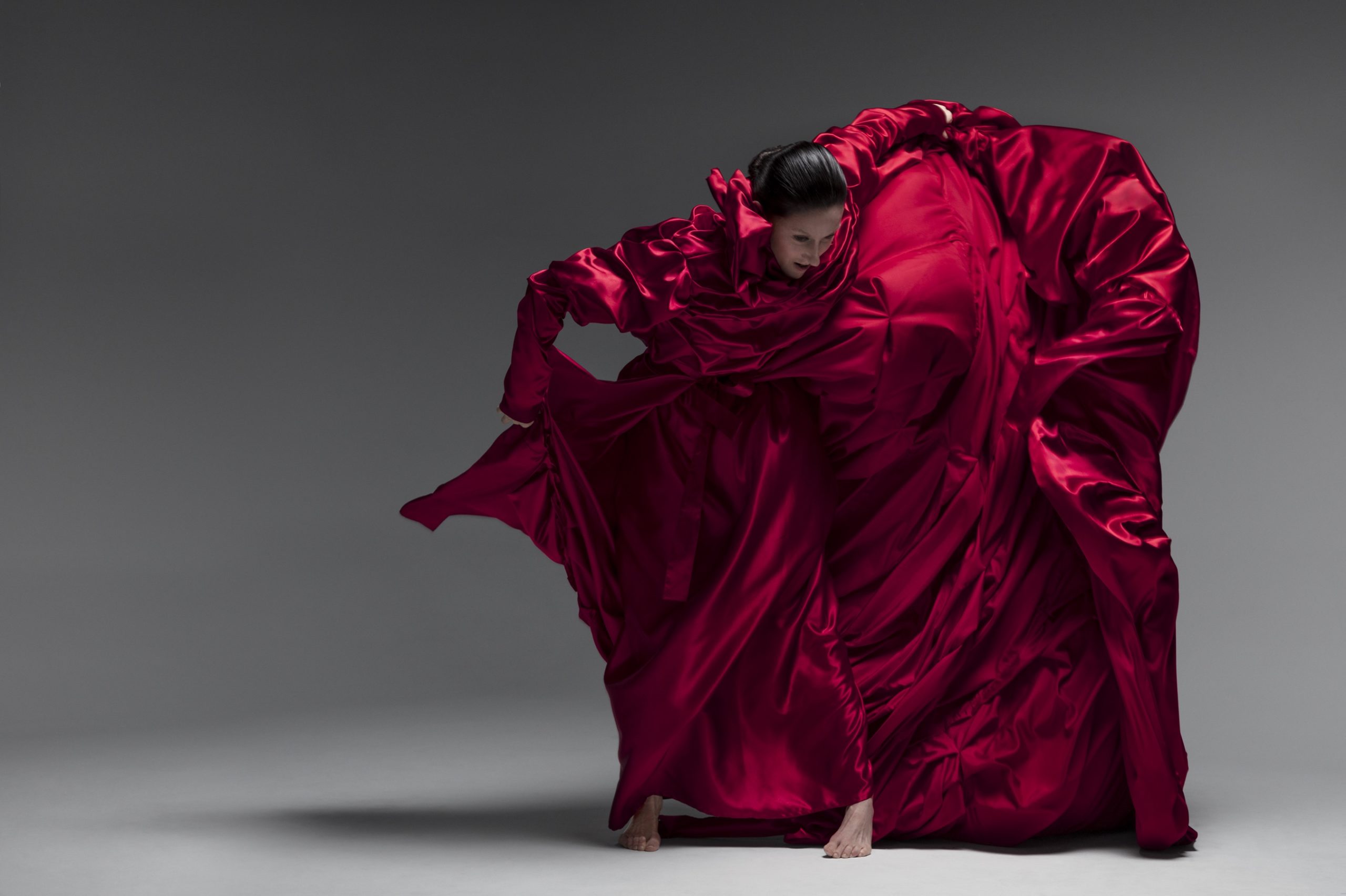Words by Pagan Hunt.
“Butoh is a shared experience”, says Vangeline – teacher, dancer, and choreographer specialising in Japanese butoh; and the experience shared on 10th November at Dance City, Newcastle, was a unique one indeed. Glorious costume, dramatic lighting, a richly layered soundscape and expertly refined movement are all brought together in Hijikata, Mon Amour, a personal tribute from Vangeline to butoh’s founder, Tatsumi Hijikata. Butoh, born out of the atomic bombing of Japan, is an intensely dark dance-theatre form, and Vangeline utilises it in a way that is refreshingly new, whilst still remaining true to the origins of the macabre ‘dance of darkness’.
The first act is dense with near-stillness. Vangeline, strikingly lit by Daniel Kersh’s design, and draped in the impressive replica of Hijikata’s crimson gown from his 1968 work Revolt of the Body, painstakingly recreated by Todd Thomas, turns at a glacial pace over her left shoulder to acknowledge the audience. We soak in her architecture, darkly glamourous, and settle gradually into the hyper-controlled and incredibly slow tempo of butoh. A single, cool, spotlight appears intermittently, along with a ghostly soprano in dialogue with Vangeline’s calm stance, now twisted into the sweeping fabric; all ghosts of what is yet to come.
This deliciously slow opening sets Vangeline in motion on a slow procession across the dark stage, like some non-human entity, carrying a profound internal power. The deep throb of Diwas Gurung’s musical accompaniment, layered with the ebb and flow of crashing ocean waves, draws attention to the passage of time. Images come to mind of a caterpillar wrapped in a cocoon, a widow in mourning, or a huge wilting flower; the stark black and red reminiscent of sumi-e ink paintings.
When Vangeline eventually settles centre-stage in a wide stance, arms raised overhead, the glamourous dress seems transformed into a warrior’s armour. She begins a torturous journey downwards, pressing in on herself into a deep squat, lips quivering with a deep anguish and a thread of drool clinging to her chin. There is an odd sensation of loss, remembering back to the glamourous, decorated profile from the start of the piece, in contrast to the grotesque creature we are now facing. Vangeline’s exquisite embodiment of emotion as a performer is at its most beautiful – and creepy – here.
We are met next with a series of intrusions to this dark state. First, an almost comedic gestural dance to Bizet’s opera Carmen, hands jerking loose from within the blood-red puddle of fabric now totally encasing Vangeline’s body. The hands seem to conduct this disembodied voice, and we are for a moment left reeling from this sudden change of pace and mood. The next intrusion comes in the form of construction noise; engines grumbling, an incessant hammering, and the infuriating beeping of vehicles reversing. Vangeline is sprawled on her back, legs akimbo, her physicality a mirror to the audience’s sensation in this moment; knocked off balance. While it is clear that Vangeline has chosen these moments to offer elements of her own French-American culture to the work, and they do provide an intriguing contrast to the previous section, I can’t help but crave a return to the quiet intensity of the first act.
Finally, she nestles back into the warm embrace of her polysatin cocoon, before emerging once more; this time transformed into a combination of flamenco dancer and matador. Prowling around the stage to Habanera from Carmen, the jarring stamps and tossing of the costume’s ruffles are steeped with an innate sensuality. This scene pays homage to Hijikata’s study and enjoyment of flamenco dance, as well as Vangeline’s French roots, and provides a compelling release of energy.
In the final scene, the outer layer of the gown is shed and we are confronted with the ghost of Hijikata himself, presented through a unique recording of his voice from 1972, ‘How to eat a watermelon’, and Vangeline’s puppeteering of the costume. The many pleats and folds now create facial features, intensely expressive and surreal under the narrow spotlight, seeming to sneer and smirk as it gradually melts to the floor, just like Vangeline did herself earlier. As the Hijikata puppet dies a slow death, we are at once full of sorrow at his passing, and filled with a kind of relief; Vangeline has laid down her burdens, perhaps the weight of history and the patriarchy, and now dances a frantic flurry of fluid gestures and beautiful softness, finally giving way to a breathless, bouncing vibration, physically shaking off the events of the last 70 minutes.
There is something to be said about sitting in the discomfort of extreme slowness, and Vangeline never leaves us there too long. It is in this space of quiet that we are able to do our work as an audience, leaning into the emotions before us and forming our own stories. Hijikata, Mon Amour is a well-paced and intensely crafted piece of work which steers clear of pretentiousness by bringing together the richly cultured history of butoh, the cross-fertilisation of Eastern and Western dance, and Vangeline’s unique, modern female perspective on the Japanese master.
Hijikata, Mon Amour was presented by Vangeline Theatre, The New York Butoh Institute, in partnership with Surface Area Dance Theatre.
Pagan Hunt participated in Moving Art Management’s Choreoview programme, which is designed to provide dance writing opportunities for writers in the north-east. DAJ supported this programme.
